Recruitment and Selection Report: Tesco and Cancer Research Centre
VerifiedAdded on 2019/12/28
|10
|2638
|205
Report
AI Summary
This report provides a comprehensive overview of the recruitment and selection processes within two organizations: Tesco and Cancer Research Centre. It identifies and analyzes the use of both internal and external recruitment sources, including promotions, transfers, and external consultants. The report also examines the impact of legal and regulatory frameworks, such as the Equality & Human Rights Commission and the Data Protection Act, on these processes. It details the preparation and purpose of key documents like job descriptions and job specifications, comparing their uses and evaluating their effectiveness in the interview process. Furthermore, the report explores the planning and participation in selection interviews, offering insights into candidate assessment and the overall selection process, including the use of application reviews, testing, and interviews. The conclusion summarizes the key findings and emphasizes the significance of effective recruitment and selection strategies in the modern business environment.
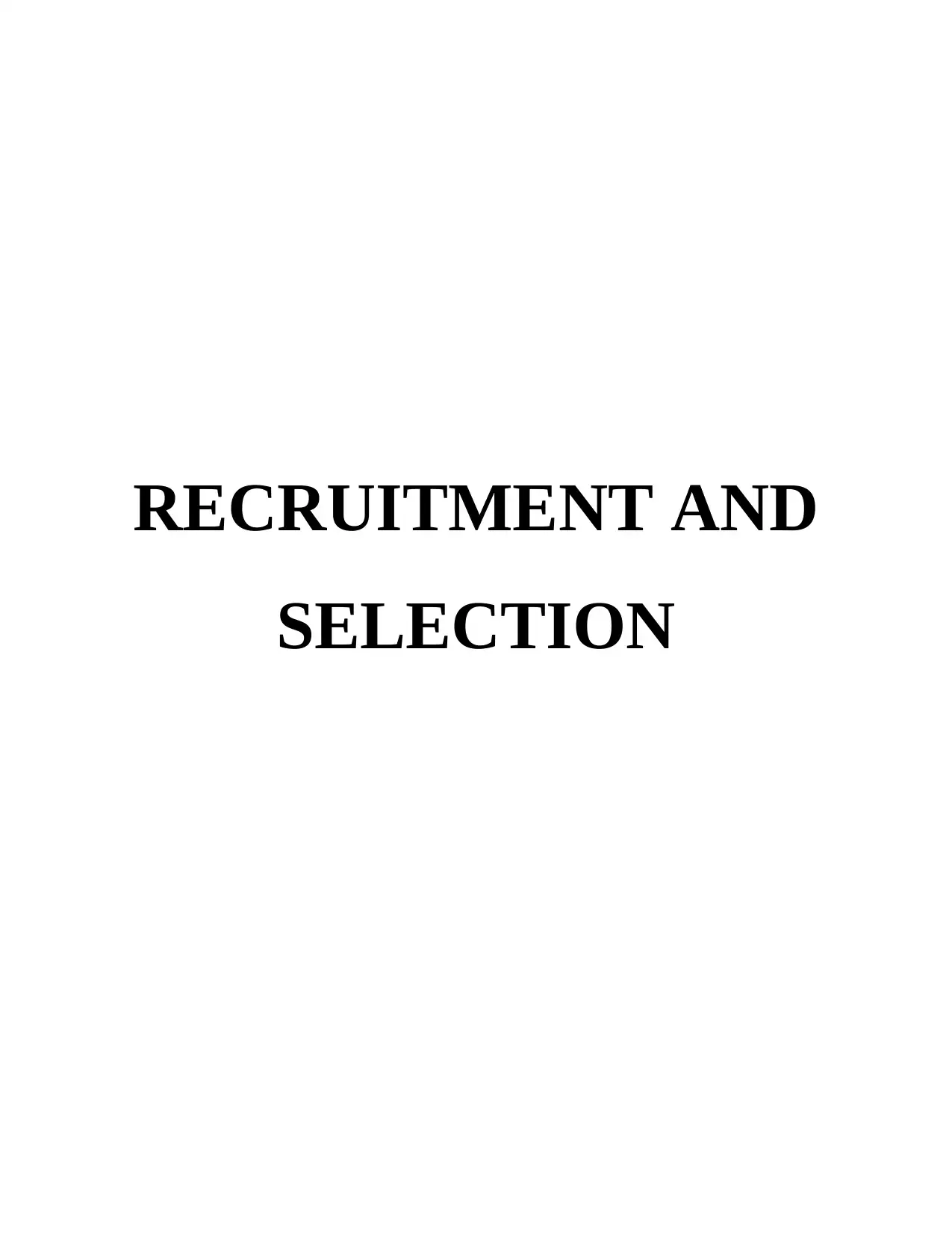
RECRUITMENT AND
SELECTION
SELECTION
Paraphrase This Document
Need a fresh take? Get an instant paraphrase of this document with our AI Paraphraser
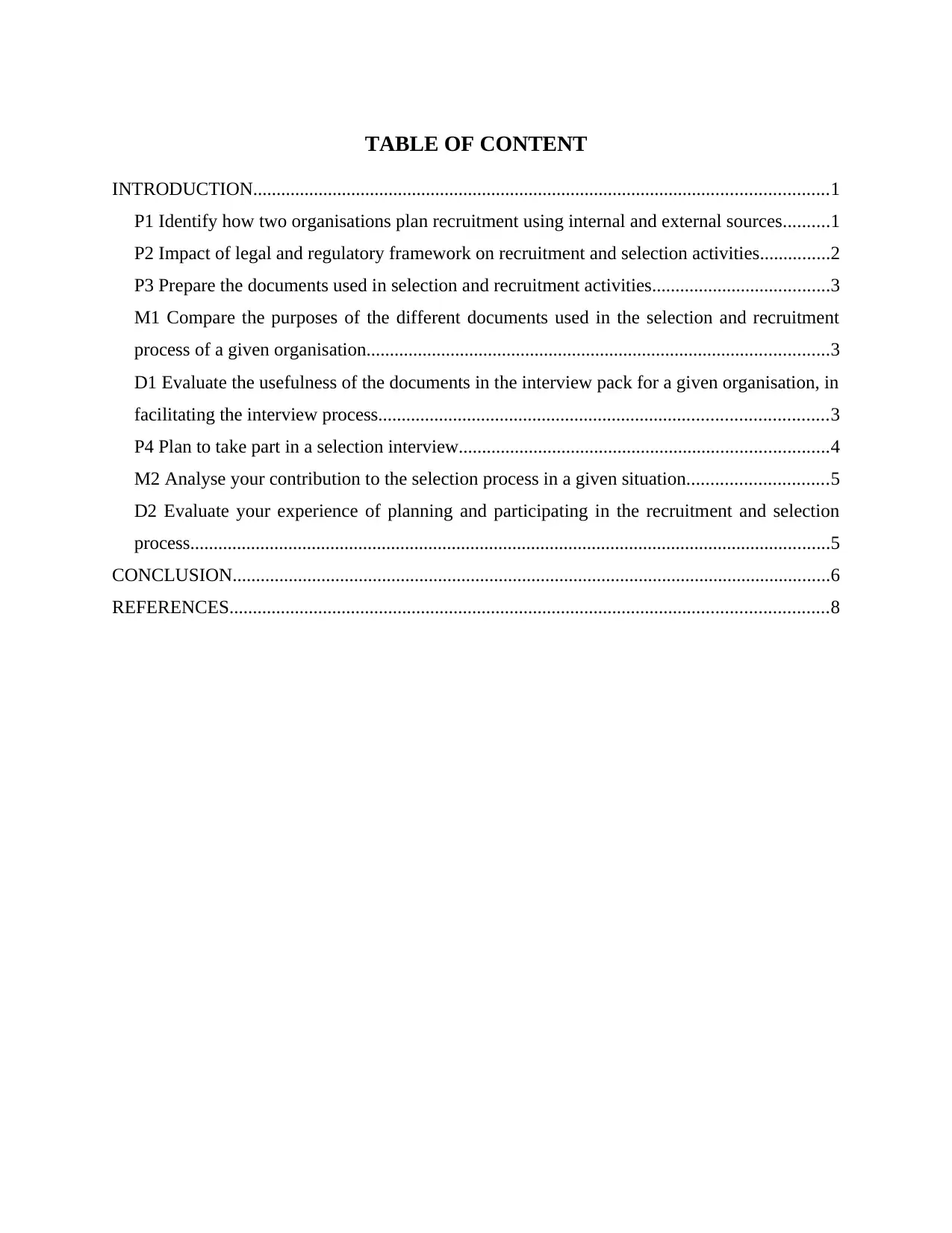
TABLE OF CONTENT
INTRODUCTION...........................................................................................................................1
P1 Identify how two organisations plan recruitment using internal and external sources..........1
P2 Impact of legal and regulatory framework on recruitment and selection activities...............2
P3 Prepare the documents used in selection and recruitment activities......................................3
M1 Compare the purposes of the different documents used in the selection and recruitment
process of a given organisation...................................................................................................3
D1 Evaluate the usefulness of the documents in the interview pack for a given organisation, in
facilitating the interview process................................................................................................3
P4 Plan to take part in a selection interview...............................................................................4
M2 Analyse your contribution to the selection process in a given situation..............................5
D2 Evaluate your experience of planning and participating in the recruitment and selection
process.........................................................................................................................................5
CONCLUSION................................................................................................................................6
REFERENCES................................................................................................................................8
INTRODUCTION...........................................................................................................................1
P1 Identify how two organisations plan recruitment using internal and external sources..........1
P2 Impact of legal and regulatory framework on recruitment and selection activities...............2
P3 Prepare the documents used in selection and recruitment activities......................................3
M1 Compare the purposes of the different documents used in the selection and recruitment
process of a given organisation...................................................................................................3
D1 Evaluate the usefulness of the documents in the interview pack for a given organisation, in
facilitating the interview process................................................................................................3
P4 Plan to take part in a selection interview...............................................................................4
M2 Analyse your contribution to the selection process in a given situation..............................5
D2 Evaluate your experience of planning and participating in the recruitment and selection
process.........................................................................................................................................5
CONCLUSION................................................................................................................................6
REFERENCES................................................................................................................................8
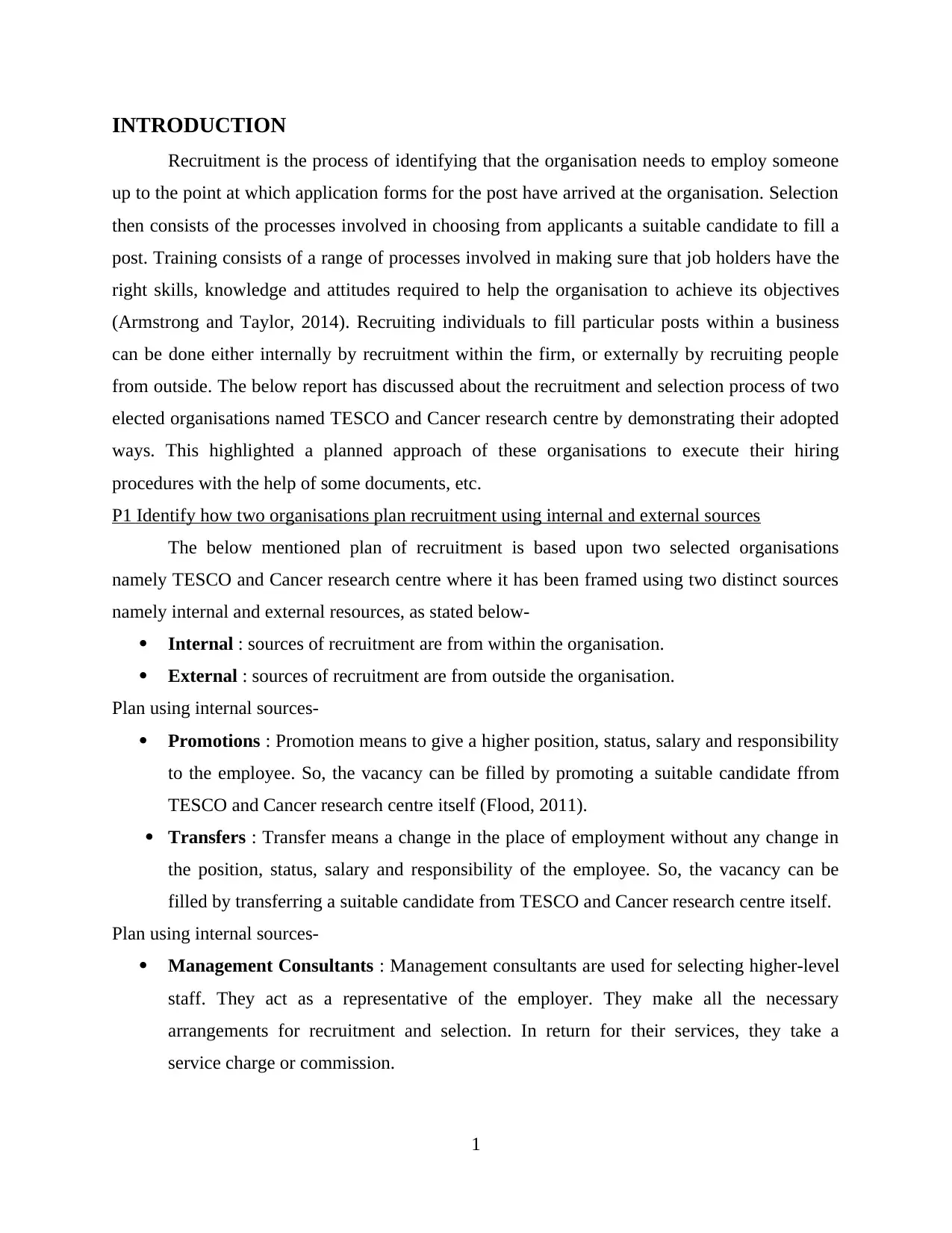
INTRODUCTION
Recruitment is the process of identifying that the organisation needs to employ someone
up to the point at which application forms for the post have arrived at the organisation. Selection
then consists of the processes involved in choosing from applicants a suitable candidate to fill a
post. Training consists of a range of processes involved in making sure that job holders have the
right skills, knowledge and attitudes required to help the organisation to achieve its objectives
(Armstrong and Taylor, 2014). Recruiting individuals to fill particular posts within a business
can be done either internally by recruitment within the firm, or externally by recruiting people
from outside. The below report has discussed about the recruitment and selection process of two
elected organisations named TESCO and Cancer research centre by demonstrating their adopted
ways. This highlighted a planned approach of these organisations to execute their hiring
procedures with the help of some documents, etc.
P1 Identify how two organisations plan recruitment using internal and external sources
The below mentioned plan of recruitment is based upon two selected organisations
namely TESCO and Cancer research centre where it has been framed using two distinct sources
namely internal and external resources, as stated below-
Internal : sources of recruitment are from within the organisation.
External : sources of recruitment are from outside the organisation.
Plan using internal sources-
Promotions : Promotion means to give a higher position, status, salary and responsibility
to the employee. So, the vacancy can be filled by promoting a suitable candidate ffrom
TESCO and Cancer research centre itself (Flood, 2011).
Transfers : Transfer means a change in the place of employment without any change in
the position, status, salary and responsibility of the employee. So, the vacancy can be
filled by transferring a suitable candidate from TESCO and Cancer research centre itself.
Plan using internal sources-
Management Consultants : Management consultants are used for selecting higher-level
staff. They act as a representative of the employer. They make all the necessary
arrangements for recruitment and selection. In return for their services, they take a
service charge or commission.
1
Recruitment is the process of identifying that the organisation needs to employ someone
up to the point at which application forms for the post have arrived at the organisation. Selection
then consists of the processes involved in choosing from applicants a suitable candidate to fill a
post. Training consists of a range of processes involved in making sure that job holders have the
right skills, knowledge and attitudes required to help the organisation to achieve its objectives
(Armstrong and Taylor, 2014). Recruiting individuals to fill particular posts within a business
can be done either internally by recruitment within the firm, or externally by recruiting people
from outside. The below report has discussed about the recruitment and selection process of two
elected organisations named TESCO and Cancer research centre by demonstrating their adopted
ways. This highlighted a planned approach of these organisations to execute their hiring
procedures with the help of some documents, etc.
P1 Identify how two organisations plan recruitment using internal and external sources
The below mentioned plan of recruitment is based upon two selected organisations
namely TESCO and Cancer research centre where it has been framed using two distinct sources
namely internal and external resources, as stated below-
Internal : sources of recruitment are from within the organisation.
External : sources of recruitment are from outside the organisation.
Plan using internal sources-
Promotions : Promotion means to give a higher position, status, salary and responsibility
to the employee. So, the vacancy can be filled by promoting a suitable candidate ffrom
TESCO and Cancer research centre itself (Flood, 2011).
Transfers : Transfer means a change in the place of employment without any change in
the position, status, salary and responsibility of the employee. So, the vacancy can be
filled by transferring a suitable candidate from TESCO and Cancer research centre itself.
Plan using internal sources-
Management Consultants : Management consultants are used for selecting higher-level
staff. They act as a representative of the employer. They make all the necessary
arrangements for recruitment and selection. In return for their services, they take a
service charge or commission.
1
⊘ This is a preview!⊘
Do you want full access?
Subscribe today to unlock all pages.

Trusted by 1+ million students worldwide
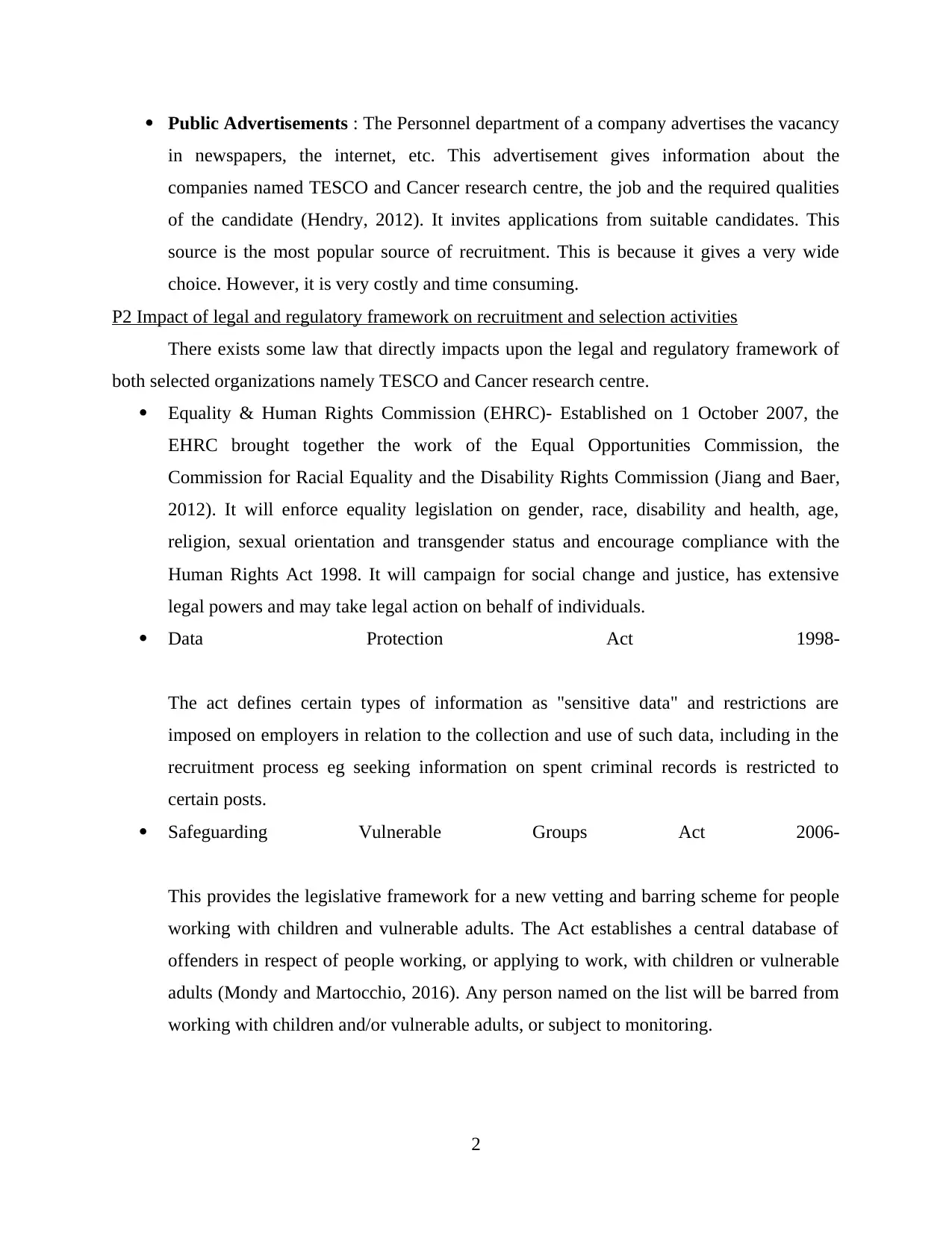
Public Advertisements : The Personnel department of a company advertises the vacancy
in newspapers, the internet, etc. This advertisement gives information about the
companies named TESCO and Cancer research centre, the job and the required qualities
of the candidate (Hendry, 2012). It invites applications from suitable candidates. This
source is the most popular source of recruitment. This is because it gives a very wide
choice. However, it is very costly and time consuming.
P2 Impact of legal and regulatory framework on recruitment and selection activities
There exists some law that directly impacts upon the legal and regulatory framework of
both selected organizations namely TESCO and Cancer research centre.
Equality & Human Rights Commission (EHRC)- Established on 1 October 2007, the
EHRC brought together the work of the Equal Opportunities Commission, the
Commission for Racial Equality and the Disability Rights Commission (Jiang and Baer,
2012). It will enforce equality legislation on gender, race, disability and health, age,
religion, sexual orientation and transgender status and encourage compliance with the
Human Rights Act 1998. It will campaign for social change and justice, has extensive
legal powers and may take legal action on behalf of individuals.
Data Protection Act 1998-
The act defines certain types of information as "sensitive data" and restrictions are
imposed on employers in relation to the collection and use of such data, including in the
recruitment process eg seeking information on spent criminal records is restricted to
certain posts.
Safeguarding Vulnerable Groups Act 2006-
This provides the legislative framework for a new vetting and barring scheme for people
working with children and vulnerable adults. The Act establishes a central database of
offenders in respect of people working, or applying to work, with children or vulnerable
adults (Mondy and Martocchio, 2016). Any person named on the list will be barred from
working with children and/or vulnerable adults, or subject to monitoring.
2
in newspapers, the internet, etc. This advertisement gives information about the
companies named TESCO and Cancer research centre, the job and the required qualities
of the candidate (Hendry, 2012). It invites applications from suitable candidates. This
source is the most popular source of recruitment. This is because it gives a very wide
choice. However, it is very costly and time consuming.
P2 Impact of legal and regulatory framework on recruitment and selection activities
There exists some law that directly impacts upon the legal and regulatory framework of
both selected organizations namely TESCO and Cancer research centre.
Equality & Human Rights Commission (EHRC)- Established on 1 October 2007, the
EHRC brought together the work of the Equal Opportunities Commission, the
Commission for Racial Equality and the Disability Rights Commission (Jiang and Baer,
2012). It will enforce equality legislation on gender, race, disability and health, age,
religion, sexual orientation and transgender status and encourage compliance with the
Human Rights Act 1998. It will campaign for social change and justice, has extensive
legal powers and may take legal action on behalf of individuals.
Data Protection Act 1998-
The act defines certain types of information as "sensitive data" and restrictions are
imposed on employers in relation to the collection and use of such data, including in the
recruitment process eg seeking information on spent criminal records is restricted to
certain posts.
Safeguarding Vulnerable Groups Act 2006-
This provides the legislative framework for a new vetting and barring scheme for people
working with children and vulnerable adults. The Act establishes a central database of
offenders in respect of people working, or applying to work, with children or vulnerable
adults (Mondy and Martocchio, 2016). Any person named on the list will be barred from
working with children and/or vulnerable adults, or subject to monitoring.
2
Paraphrase This Document
Need a fresh take? Get an instant paraphrase of this document with our AI Paraphraser

P3 Prepare the documents used in selection and recruitment activities
There exists two main documents used to perform the activities of recruitment and
selection as specified below-
Job Specification is a statement of the essential components of a job class including a
summary of the work to be performed, primary duties and responsibilities, and the
minimum qualifications and requirements necessary to perform the essential functions of
the job (Job Description and Person Specification, 2013).
Job description will set out how a particular employee will fit into the organisation. It will
therefore need to set out:
the title of the job
to whom the employee is responsible
for whom the employee is responsible
a simple description of the role and duties of the employee within the organisation.
A job description could be used as a job indicator for applicants for a job. Alternatively, it
could be used as a guideline for an employee and/or his or her line manager as to his or
her role and responsibility within the organisation.
M1 Compare the purposes of the different documents used in the selection and recruitment
process of a given organisation
The main purpose of any job description is to outline the main duties and responsibilities
that are involved in a particular job (Bennett and Ho, 2014). Additional information is often
requested in order that one document can fulfil the needs of several processes, such as:
recruitment and selection; appraisal; job evaluation and training.
Also, known as employee specifications, a job specification is a written statement of
educational qualifications, specific qualities, level of experience, physical, emotional, technical
and communication skills required to perform a job, responsibilities involved in a job and other
unusual sensory demands (Glasby and Dickinson, 2009).
D1 Evaluate the usefulness of the documents in the interview pack for a given organisation, in
facilitating the interview process
Advantages of Job Description
1. It helps the supervisors in assigning work to the subordinates so that he can guide and
monitor their performances.
3
There exists two main documents used to perform the activities of recruitment and
selection as specified below-
Job Specification is a statement of the essential components of a job class including a
summary of the work to be performed, primary duties and responsibilities, and the
minimum qualifications and requirements necessary to perform the essential functions of
the job (Job Description and Person Specification, 2013).
Job description will set out how a particular employee will fit into the organisation. It will
therefore need to set out:
the title of the job
to whom the employee is responsible
for whom the employee is responsible
a simple description of the role and duties of the employee within the organisation.
A job description could be used as a job indicator for applicants for a job. Alternatively, it
could be used as a guideline for an employee and/or his or her line manager as to his or
her role and responsibility within the organisation.
M1 Compare the purposes of the different documents used in the selection and recruitment
process of a given organisation
The main purpose of any job description is to outline the main duties and responsibilities
that are involved in a particular job (Bennett and Ho, 2014). Additional information is often
requested in order that one document can fulfil the needs of several processes, such as:
recruitment and selection; appraisal; job evaluation and training.
Also, known as employee specifications, a job specification is a written statement of
educational qualifications, specific qualities, level of experience, physical, emotional, technical
and communication skills required to perform a job, responsibilities involved in a job and other
unusual sensory demands (Glasby and Dickinson, 2009).
D1 Evaluate the usefulness of the documents in the interview pack for a given organisation, in
facilitating the interview process
Advantages of Job Description
1. It helps the supervisors in assigning work to the subordinates so that he can guide and
monitor their performances.
3

2. It helps in recruitment and selection procedures.
3. It assists in manpower planning.
4. It is also helpful in performance appraisal.
5. It is helpful in job evaluation in order to decide about rate of remuneration for a specific
job.
6. It also helps in chalking out training and development programmes.
Advantages of Job Specification
1. It is helpful in preliminary screening in the selection procedure.
2. It helps in giving due justification to each job.
3. It also helps in designing training and development programmes.
4. It helps the supervisors for counselling and monitoring performance of employees.
5. It helps in job evaluation.
6. It helps the management to take decisions regarding promotion, transfers and giving extra
benefits to the employees.
P4 Plan to take part in a selection interview
Selection is the process of screening applicants to ensure that the most appropriate
candidate is hired. The first step in the selection process is to review the information (resume,
application form) provided by all job applicants to determine which applicants meet the
minimum qualifications as stated in the job posting (Jackson, Schuler and Werner, 2011). No
further consideration will be given to those who do not meet the minimum qualifications. Those
job applicants who meet or exceed the minimum job qualifications are then assessed to decide
which ones will be short-listed for a job interview.
The most common methods of selection for all positions include an interview followed
by a reference check. Other selection techniques used during the interview phase are: work
samples, written tests, in basket exercises, oral presentation, and personality or aptitude tests
(Mathis and Meglich, 2016). After making a conditional offer, additional selection techniques
can include: criminal records check, driver's records check. Written consent is required before
requesting records checks.
4
3. It assists in manpower planning.
4. It is also helpful in performance appraisal.
5. It is helpful in job evaluation in order to decide about rate of remuneration for a specific
job.
6. It also helps in chalking out training and development programmes.
Advantages of Job Specification
1. It is helpful in preliminary screening in the selection procedure.
2. It helps in giving due justification to each job.
3. It also helps in designing training and development programmes.
4. It helps the supervisors for counselling and monitoring performance of employees.
5. It helps in job evaluation.
6. It helps the management to take decisions regarding promotion, transfers and giving extra
benefits to the employees.
P4 Plan to take part in a selection interview
Selection is the process of screening applicants to ensure that the most appropriate
candidate is hired. The first step in the selection process is to review the information (resume,
application form) provided by all job applicants to determine which applicants meet the
minimum qualifications as stated in the job posting (Jackson, Schuler and Werner, 2011). No
further consideration will be given to those who do not meet the minimum qualifications. Those
job applicants who meet or exceed the minimum job qualifications are then assessed to decide
which ones will be short-listed for a job interview.
The most common methods of selection for all positions include an interview followed
by a reference check. Other selection techniques used during the interview phase are: work
samples, written tests, in basket exercises, oral presentation, and personality or aptitude tests
(Mathis and Meglich, 2016). After making a conditional offer, additional selection techniques
can include: criminal records check, driver's records check. Written consent is required before
requesting records checks.
4
⊘ This is a preview!⊘
Do you want full access?
Subscribe today to unlock all pages.

Trusted by 1+ million students worldwide
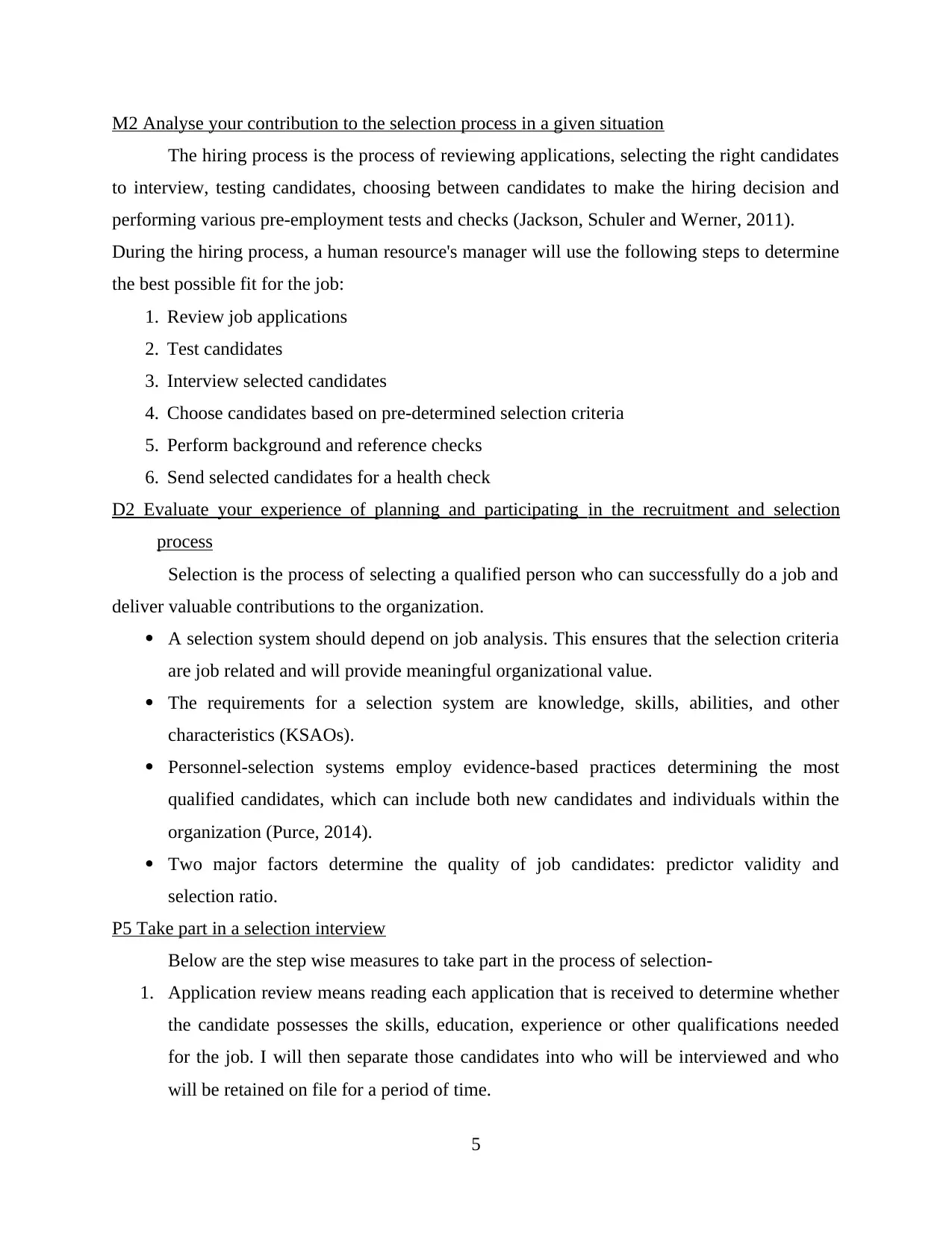
M2 Analyse your contribution to the selection process in a given situation
The hiring process is the process of reviewing applications, selecting the right candidates
to interview, testing candidates, choosing between candidates to make the hiring decision and
performing various pre-employment tests and checks (Jackson, Schuler and Werner, 2011).
During the hiring process, a human resource's manager will use the following steps to determine
the best possible fit for the job:
1. Review job applications
2. Test candidates
3. Interview selected candidates
4. Choose candidates based on pre-determined selection criteria
5. Perform background and reference checks
6. Send selected candidates for a health check
D2 Evaluate your experience of planning and participating in the recruitment and selection
process
Selection is the process of selecting a qualified person who can successfully do a job and
deliver valuable contributions to the organization.
A selection system should depend on job analysis. This ensures that the selection criteria
are job related and will provide meaningful organizational value.
The requirements for a selection system are knowledge, skills, abilities, and other
characteristics (KSAOs).
Personnel-selection systems employ evidence-based practices determining the most
qualified candidates, which can include both new candidates and individuals within the
organization (Purce, 2014).
Two major factors determine the quality of job candidates: predictor validity and
selection ratio.
P5 Take part in a selection interview
Below are the step wise measures to take part in the process of selection-
1. Application review means reading each application that is received to determine whether
the candidate possesses the skills, education, experience or other qualifications needed
for the job. I will then separate those candidates into who will be interviewed and who
will be retained on file for a period of time.
5
The hiring process is the process of reviewing applications, selecting the right candidates
to interview, testing candidates, choosing between candidates to make the hiring decision and
performing various pre-employment tests and checks (Jackson, Schuler and Werner, 2011).
During the hiring process, a human resource's manager will use the following steps to determine
the best possible fit for the job:
1. Review job applications
2. Test candidates
3. Interview selected candidates
4. Choose candidates based on pre-determined selection criteria
5. Perform background and reference checks
6. Send selected candidates for a health check
D2 Evaluate your experience of planning and participating in the recruitment and selection
process
Selection is the process of selecting a qualified person who can successfully do a job and
deliver valuable contributions to the organization.
A selection system should depend on job analysis. This ensures that the selection criteria
are job related and will provide meaningful organizational value.
The requirements for a selection system are knowledge, skills, abilities, and other
characteristics (KSAOs).
Personnel-selection systems employ evidence-based practices determining the most
qualified candidates, which can include both new candidates and individuals within the
organization (Purce, 2014).
Two major factors determine the quality of job candidates: predictor validity and
selection ratio.
P5 Take part in a selection interview
Below are the step wise measures to take part in the process of selection-
1. Application review means reading each application that is received to determine whether
the candidate possesses the skills, education, experience or other qualifications needed
for the job. I will then separate those candidates into who will be interviewed and who
will be retained on file for a period of time.
5
Paraphrase This Document
Need a fresh take? Get an instant paraphrase of this document with our AI Paraphraser
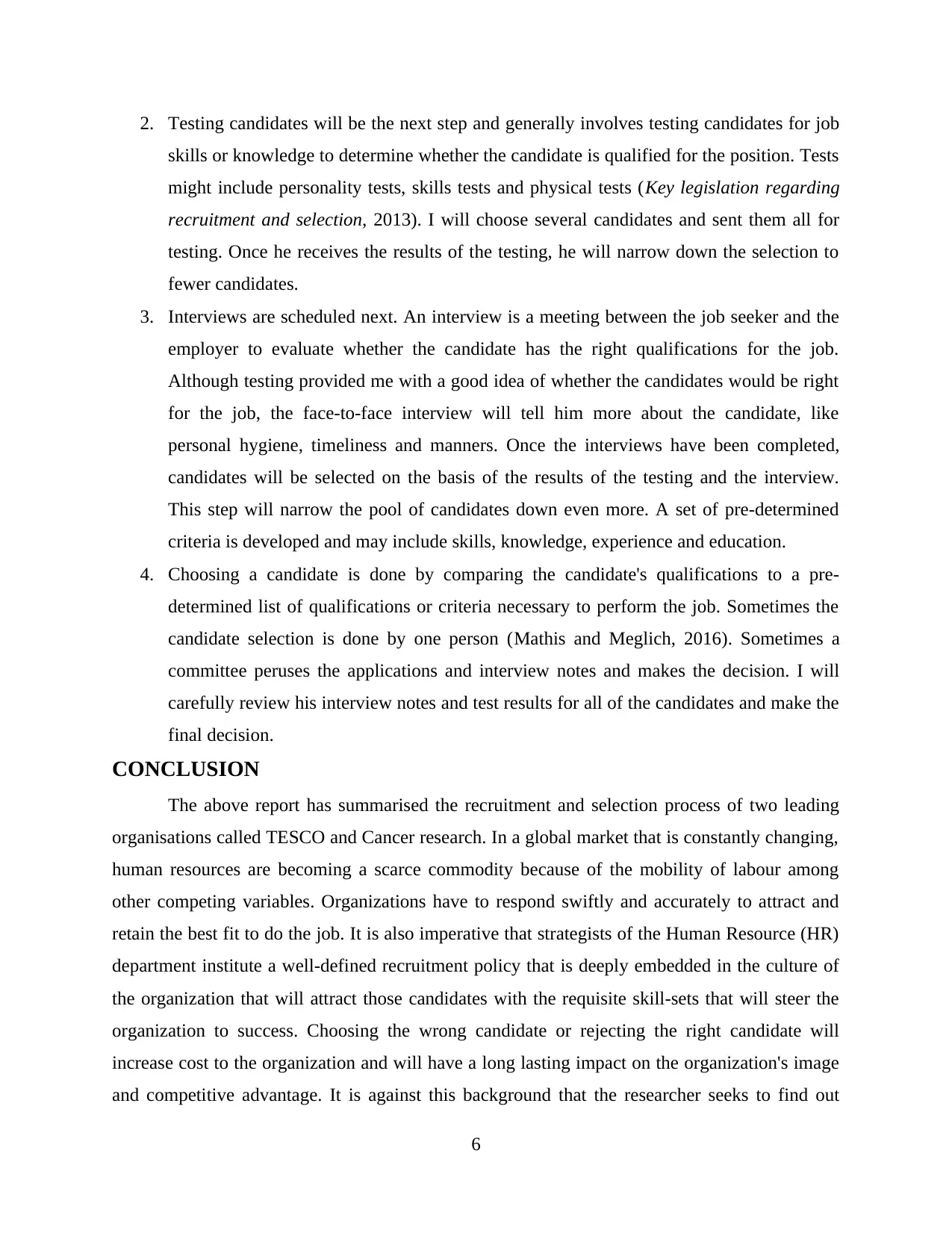
2. Testing candidates will be the next step and generally involves testing candidates for job
skills or knowledge to determine whether the candidate is qualified for the position. Tests
might include personality tests, skills tests and physical tests (Key legislation regarding
recruitment and selection, 2013). I will choose several candidates and sent them all for
testing. Once he receives the results of the testing, he will narrow down the selection to
fewer candidates.
3. Interviews are scheduled next. An interview is a meeting between the job seeker and the
employer to evaluate whether the candidate has the right qualifications for the job.
Although testing provided me with a good idea of whether the candidates would be right
for the job, the face-to-face interview will tell him more about the candidate, like
personal hygiene, timeliness and manners. Once the interviews have been completed,
candidates will be selected on the basis of the results of the testing and the interview.
This step will narrow the pool of candidates down even more. A set of pre-determined
criteria is developed and may include skills, knowledge, experience and education.
4. Choosing a candidate is done by comparing the candidate's qualifications to a pre-
determined list of qualifications or criteria necessary to perform the job. Sometimes the
candidate selection is done by one person (Mathis and Meglich, 2016). Sometimes a
committee peruses the applications and interview notes and makes the decision. I will
carefully review his interview notes and test results for all of the candidates and make the
final decision.
CONCLUSION
The above report has summarised the recruitment and selection process of two leading
organisations called TESCO and Cancer research. In a global market that is constantly changing,
human resources are becoming a scarce commodity because of the mobility of labour among
other competing variables. Organizations have to respond swiftly and accurately to attract and
retain the best fit to do the job. It is also imperative that strategists of the Human Resource (HR)
department institute a well-defined recruitment policy that is deeply embedded in the culture of
the organization that will attract those candidates with the requisite skill-sets that will steer the
organization to success. Choosing the wrong candidate or rejecting the right candidate will
increase cost to the organization and will have a long lasting impact on the organization's image
and competitive advantage. It is against this background that the researcher seeks to find out
6
skills or knowledge to determine whether the candidate is qualified for the position. Tests
might include personality tests, skills tests and physical tests (Key legislation regarding
recruitment and selection, 2013). I will choose several candidates and sent them all for
testing. Once he receives the results of the testing, he will narrow down the selection to
fewer candidates.
3. Interviews are scheduled next. An interview is a meeting between the job seeker and the
employer to evaluate whether the candidate has the right qualifications for the job.
Although testing provided me with a good idea of whether the candidates would be right
for the job, the face-to-face interview will tell him more about the candidate, like
personal hygiene, timeliness and manners. Once the interviews have been completed,
candidates will be selected on the basis of the results of the testing and the interview.
This step will narrow the pool of candidates down even more. A set of pre-determined
criteria is developed and may include skills, knowledge, experience and education.
4. Choosing a candidate is done by comparing the candidate's qualifications to a pre-
determined list of qualifications or criteria necessary to perform the job. Sometimes the
candidate selection is done by one person (Mathis and Meglich, 2016). Sometimes a
committee peruses the applications and interview notes and makes the decision. I will
carefully review his interview notes and test results for all of the candidates and make the
final decision.
CONCLUSION
The above report has summarised the recruitment and selection process of two leading
organisations called TESCO and Cancer research. In a global market that is constantly changing,
human resources are becoming a scarce commodity because of the mobility of labour among
other competing variables. Organizations have to respond swiftly and accurately to attract and
retain the best fit to do the job. It is also imperative that strategists of the Human Resource (HR)
department institute a well-defined recruitment policy that is deeply embedded in the culture of
the organization that will attract those candidates with the requisite skill-sets that will steer the
organization to success. Choosing the wrong candidate or rejecting the right candidate will
increase cost to the organization and will have a long lasting impact on the organization's image
and competitive advantage. It is against this background that the researcher seeks to find out
6
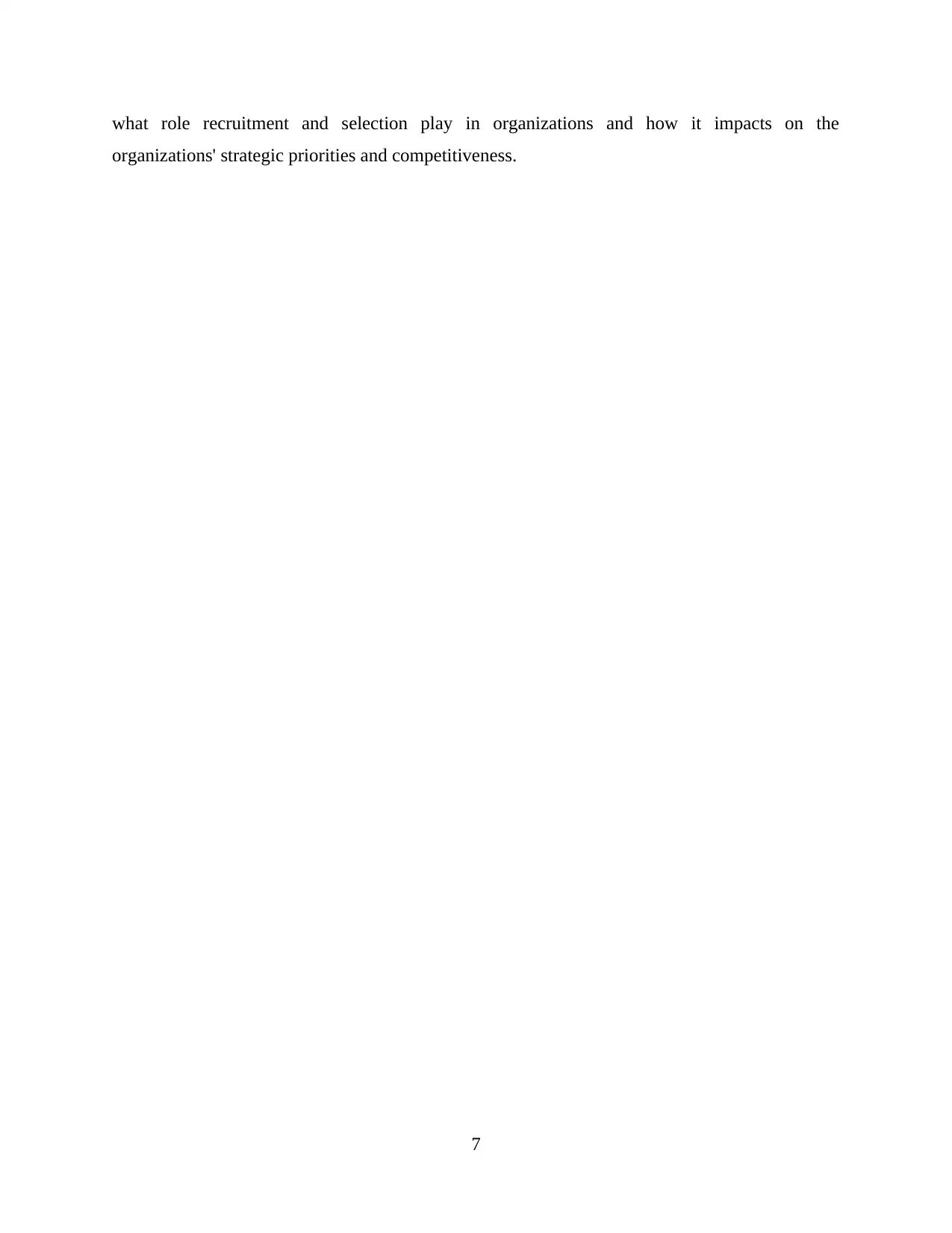
what role recruitment and selection play in organizations and how it impacts on the
organizations' strategic priorities and competitiveness.
7
organizations' strategic priorities and competitiveness.
7
⊘ This is a preview!⊘
Do you want full access?
Subscribe today to unlock all pages.

Trusted by 1+ million students worldwide
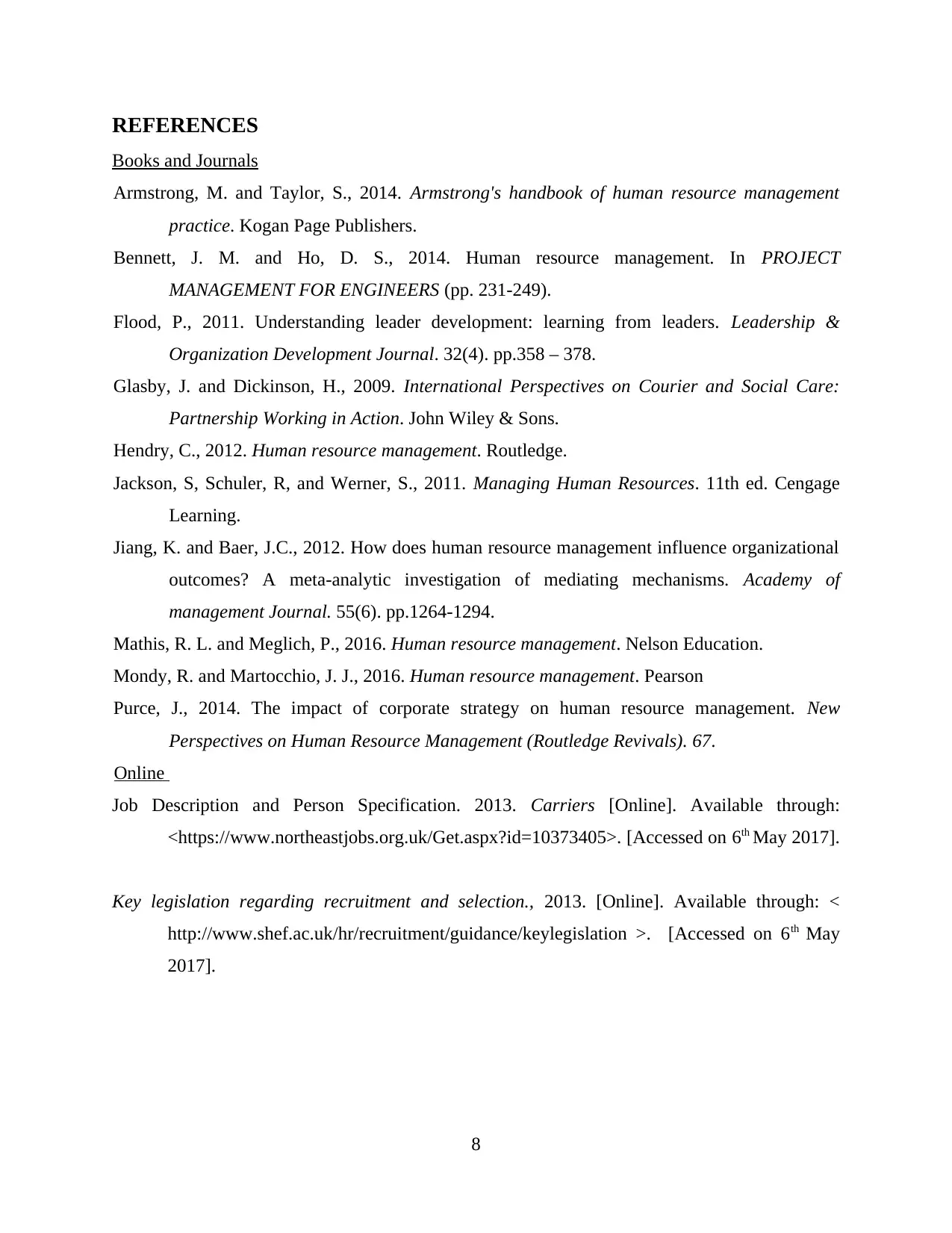
REFERENCES
Books and Journals
Armstrong, M. and Taylor, S., 2014. Armstrong's handbook of human resource management
practice. Kogan Page Publishers.
Bennett, J. M. and Ho, D. S., 2014. Human resource management. In PROJECT
MANAGEMENT FOR ENGINEERS (pp. 231-249).
Flood, P., 2011. Understanding leader development: learning from leaders. Leadership &
Organization Development Journal. 32(4). pp.358 – 378.
Glasby, J. and Dickinson, H., 2009. International Perspectives on Courier and Social Care:
Partnership Working in Action. John Wiley & Sons.
Hendry, C., 2012. Human resource management. Routledge.
Jackson, S, Schuler, R, and Werner, S., 2011. Managing Human Resources. 11th ed. Cengage
Learning.
Jiang, K. and Baer, J.C., 2012. How does human resource management influence organizational
outcomes? A meta-analytic investigation of mediating mechanisms. Academy of
management Journal. 55(6). pp.1264-1294.
Mathis, R. L. and Meglich, P., 2016. Human resource management. Nelson Education.
Mondy, R. and Martocchio, J. J., 2016. Human resource management. Pearson
Purce, J., 2014. The impact of corporate strategy on human resource management. New
Perspectives on Human Resource Management (Routledge Revivals). 67.
Online
Job Description and Person Specification. 2013. Carriers [Online]. Available through:
<https://www.northeastjobs.org.uk/Get.aspx?id=10373405>. [Accessed on 6th May 2017].
Key legislation regarding recruitment and selection., 2013. [Online]. Available through: <
http://www.shef.ac.uk/hr/recruitment/guidance/keylegislation >. [Accessed on 6th May
2017].
8
Books and Journals
Armstrong, M. and Taylor, S., 2014. Armstrong's handbook of human resource management
practice. Kogan Page Publishers.
Bennett, J. M. and Ho, D. S., 2014. Human resource management. In PROJECT
MANAGEMENT FOR ENGINEERS (pp. 231-249).
Flood, P., 2011. Understanding leader development: learning from leaders. Leadership &
Organization Development Journal. 32(4). pp.358 – 378.
Glasby, J. and Dickinson, H., 2009. International Perspectives on Courier and Social Care:
Partnership Working in Action. John Wiley & Sons.
Hendry, C., 2012. Human resource management. Routledge.
Jackson, S, Schuler, R, and Werner, S., 2011. Managing Human Resources. 11th ed. Cengage
Learning.
Jiang, K. and Baer, J.C., 2012. How does human resource management influence organizational
outcomes? A meta-analytic investigation of mediating mechanisms. Academy of
management Journal. 55(6). pp.1264-1294.
Mathis, R. L. and Meglich, P., 2016. Human resource management. Nelson Education.
Mondy, R. and Martocchio, J. J., 2016. Human resource management. Pearson
Purce, J., 2014. The impact of corporate strategy on human resource management. New
Perspectives on Human Resource Management (Routledge Revivals). 67.
Online
Job Description and Person Specification. 2013. Carriers [Online]. Available through:
<https://www.northeastjobs.org.uk/Get.aspx?id=10373405>. [Accessed on 6th May 2017].
Key legislation regarding recruitment and selection., 2013. [Online]. Available through: <
http://www.shef.ac.uk/hr/recruitment/guidance/keylegislation >. [Accessed on 6th May
2017].
8
1 out of 10
Related Documents
Your All-in-One AI-Powered Toolkit for Academic Success.
+13062052269
info@desklib.com
Available 24*7 on WhatsApp / Email
![[object Object]](/_next/static/media/star-bottom.7253800d.svg)
Unlock your academic potential
Copyright © 2020–2025 A2Z Services. All Rights Reserved. Developed and managed by ZUCOL.





